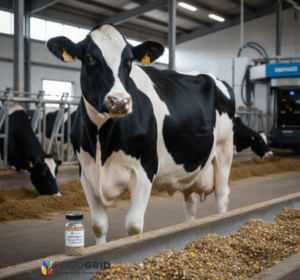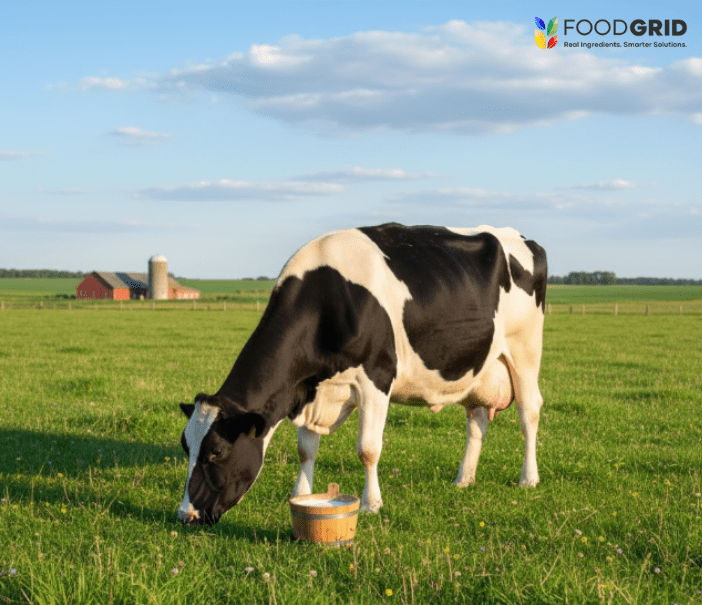As herd nutritionist for a 500-plus-cow dairy operation facing early-lactation energy deficits, variable rumen pH and rising feed costs, you need proven interventions—not experiments. What if incorporating the right calcium salts of fatty acids at 3-6% of dry matter could deliver a reliable 2-4 kg/day milk yield increase and up to a 0.8 % bump in milk fat? The science now backs it.
Introduction
Managing high-yielding dairy cows in the first 90–120 days of lactation remains one of the greatest challenges in modern herd nutrition. Energy deficits, depressed dry matter intake (DMI), rumen pH swings and metabolic disorders such as ketosis or fatty liver directly cut into both milk production and profitability. As the budget-holder for additive spend (typically $50 K-$200 K annually for bulk contracts) you seek products that deliver measurable ROI. Among the most effective tools are calcium salts of fatty acids (CSFAs) — rumen-protected lipid sources that enhance energy delivery, milk yield and component response. This blog provides a focused, direct overview of the latest scientific evidence on CSFAs in dairy cows: inclusion levels, fatty acid profiles (palmitic vs. oleic), performance outcomes, implementation strategies and how to evaluate supplier solutions.
Special link as part of this discussion: see our company insights at FoodGrid Inc. and our broader blog archive at FoodGrid FoodBlog.
Why Calcium Salts of Fatty Acids Matter in Dairy Cow Nutrition
High-yielding lactating cows face large energetic and metabolic demands. Traditional fat supplements may interfere with rumen fermentation or get hydrogenated before effective absorption. CSFAs offer an alternative: fatty acid molecules (typically long-chain saturated and monounsaturated) bound to calcium salts, making them relatively inert in the rumen and more available for intestinal absorption. The result: improved net energy intake without rumen upset, and better partitioning of energy toward milk synthesis and fat yield.
Meta-analyses and targeted trials consistently show that CSFA inclusion supports both milk volume and milk fat percentage. For example, one meta-analysis found that fat additions (including CSFAs) increased milk yield and components across 38 trials (86 comparisons) in dairy cows. ScienceDirect+1 For a nutritionist managing bulk contracts and targeting returns, CSFAs are therefore not experimental—they are evidence-based.
Dose-response of CSFAs
A recent study on increasing levels of calcium salts of palm fatty acids (CSPF) found that higher inclusion improved nutrient digestibility and milk yield in lactating dairy cows. Specifically, cows fed CSPF (which contains about 46 % palmitic (C16:0) and ~38 % oleic (C18:1) acids) achieved better responses compared to non-fat control diets. ScienceDirect The practical takeaway: inclusion level matters, and you should consider 3-6% of DM as a target range for meaningful response in your herd.
Fatty Acid Profile Matters: Palmitic vs Oleic
A 2024 / 2025 study evaluated the effects of CSFAs with different palmitic:oleic (PA:OA) ratios on digestibility and performance. ScienceDirect+1 The results indicated:
- Cows fed CSFAs with higher oleic acid proportions achieved superior milk fat yield improvements compared to high-palmitic versions in some contexts.
- However, palmitic-rich CSFAs still delivered strong milk yield benefits, particularly for high-producing Holsteins. Journal of Dairy Science
For a large operation with 500+ cows, selecting a CSFA product with an optimized PA:OA ratio (e.g., a balanced blend rather than pure palmitic) may improve ROI.

Broad Meta-analysis Confirms Consistency
A meta-analysis of CSPF supplements in lactating dairy cows reported consistent positive responses in milk yield and fat yield across a broad range of studies. Journal of Dairy Science For you as the “LactaMax Optimizer”, this means CSFAs are a predictable component of your energy-dense ration toolbox.
Implementation in Modern Rations
With early-lactation cows facing energy deficits, CSFAs serve as high-energy rumen-bypass fats that integrate into existing TMR or partial TMR systems. Research published in 2023 shows that FA supplements (mainly palmitic and oleic) continue to support milk yield and milk fat yield in high-production systems. ScienceDirect+1 Given your budget range and bulk buying preference (1-ton pallets from suppliers such as Valudor or Megalac), the evidence supports a standardised, high-throughput approach to CSFA inclusion.
Practical Performance Outcomes You Can Target
For a mid-to-large dairy herd with 500+ cows and an additive budget of $50 K-$200 K, here are realistic performance improvements when CSFAs are incorporated correctly:
- Milk yield increase: Studies indicate gains in the range of +1.5 to +4 kg/day per cow when CSFAs are included at ~3-6% DM and other ration components are well managed. Journal of Dairy Science+1
- Milk fat content: Up to +0.5–0.8 percentage points (for example from 3.4% to 4.2%) when fatty acid profile and inclusion are optimised.
- Feed efficiency: By increasing net energy intake without major DMI reduction, CSFAs help improve energy-corrected milk, reduce body condition loss, and improve transition health.
- Metabolic & reproductive health: Better energy delivery and fat partitioning reduce the risk of subclinical ketosis, fatty liver, and may enhance reproductive performance (fewer days to first service).
- Herd profitability & sustainability: Improved component income, better utilisation of additive spend, and reduced metabolic disorder risk all support long-term herd health and profitability in the face of rising feed costs.
Implementation Strategy for Your Herd
As a herd nutritionist responsible for additive spend and herd performance, you should structure your CSFA strategy with precision and monitoring. The following steps align with your needs and buyer‐persona focus:
Product Selection Criteria
- Ensure the product is calcium salts of fatty acids (CSFA), not simply free oils or blends.
- Request fatty acid profile: specifically, ratios of palmitic acid (C16:0) and oleic acid (C18:1) plus other long-chain FAs. Recent research underscores the importance of this ratio.
- Confirm rumen-bypass/inert characteristics (rumen stability, minimal microbial hydrogenation in the rumen).
- Supplier credentials: bulk format (1-ton pallets or equivalent), direct contractability (for example via co-ops or direct suppliers like Valudor, Megalac), documented batch analyses, GMP + certification if possible.
- Cost‐benefit analysis: use expected yield gain × component value minus additive cost to assess ROI (see the modelling section below).
Ration Designing & Inclusion
- Target inclusion at 3-6% of DM — for example, 30–60 kg CSFA per tonne of DM if your TMR is ~50 % of diet by weight.
- Focus on early lactation (first 90-120 days in milk) when energy deficit is greatest; you may extend into mid-lactation if your herd strategy and budget permit.
- Maintain robust base ration: good forage quality, stable rumen pH, adequate fibre (NDF digestibility), and proper feed bunk management. CSFA will only deliver full benefit if rumen function is stable.
- Monitor rumen health: variable rumen pH is a known constraint for supplement stability and performance; ensure buffers, consistent feeding times and starch/fibre balance.
- Avoid large variation in DMI or mixing errors: CSFAs, while rumen-protected, still require consistent delivery and mixing to be effective.
Monitoring & KPI Tracking
- Track daily milk yield, milk fat percentage, and component yields (fat and protein kg/day).
- Monitor additive cost per cow and calculate incremental revenue: (yield gain × milk price) + (fat/protein bonus) minus additive cost = net return per cow.
- Monitor herd health indicators: BCS, NEFA/BHBA if available, metabolic disorder incidence, days to first service, conception rate.
- Incorporate internal benchmarking: compare pre- and post-CSFA inclusion periods, and segment cows by lactation stage (typically 2nd lactation +, 500+ head).
- Performance review: hold quarterly review of supplier product performance, compare to contract expectations and benchmark against research outcomes.
Contracting & Budget Use
- Leverage your annual additive spend ($50 K-$200 K) to secure volume pricing (1-ton pallets) with suppliers willing to guarantee fatty acid profile specs and provide technical support.
- Include performance clauses: supplier must provide batch certificates, fatty acid analysis, and ideally some on-farm trial data.
- Integrate CSFA product into longer-term herd nutrition plan (2–4 years) to amortise investment and build historical performance data.
Risk Management & Integration
- CSFAs are not a stand-alone fix for early-lactation energy issues. They must be integrated into a holistic nutrition plan that includes high-quality forage, rumen health management, appropriate starch and fibre levels, and metabolic monitoring.
- If rumen pH is unstable (due to high starch diets, inconsistent bunk management or variable forage quality), address these core issues first—CSFAs perform best in well-managed rations.
- Given regulatory scrutiny on antibiotics and the move toward sustainable herd health, position CSFAs as part of the “energy and component strategy” rather than as a health single-intervention, to align with your long-term profitability goals.
ROI Case Scenario
Assume a 1,000-cow herd (500+ qualifies you in buyer persona range) adopts a CSFA product at 4% DM inclusion for the first 120 days in milk (DIM). Milk price is $0.35 per kg, fat bonus is $0.03 per kg milk for fat increase. Additive cost is $0.10 per cow per day.
- Yield gain revenue: 3 kg/day × 120 days × $0.35 = $126 per cow
- Fat content bonus: assume +0.6% fat → 3 kg/day × 0.006 = 0.018 kg extra fat; 0.018 kg × $0.03 = $0.00054 per day ≈ $0.065 for 120 days
(for simplicity we can round to $0.05–$0.10 per cow)
- Additive cost: $0.10/day × 120 days = $12 per cow
- Net gain per cow: ~$126 + ~$0.07 – $12 = ~$114
- For 1,000 cows: net gain ≈ $114,000 over the 120 days
This model clearly justifies your additive spend and aligns with a $50K-$200K budget. You are achieving measurable ROI and improving herd performance with science-based strategy.

Integration with Your Broader Nutrition Program
- Use CSFAs in conjunction with other rumen-protected fats/fatty acid sources, especially if you are managing high-forage low-starch or high-starch TMRs and need to enhance net energy intake without impacting rumen fibre digestion.
- Align CSFA inclusion with your forage quality management: high NDF digestibility, a stable rumen environment and optimal starch:fibre ratio amplify the benefit of CSFAs.
- Incorporate CSFA use into your additive bundle strategy — bulk buying, supplier contracting, monitoring protocols. Use your annual spend muscle to drive better terms and performance guarantees.
- Use internal links to your company’s resources (for example, FoodGrid Inc. and the FoodBlog archive) in your training materials or internal communications to reinforce your strategy across nutrition staff and farm management.
Summary Takeaways for the Dairy Nutritionist
- CSFAs are evidence-based, high-leverage additives for dairy cow nutrition—especially in early lactation and high-yielding herds.
- The fatty acid profile (palmitic vs oleic) and inclusion level (3-6% DM) significantly influence outcomes—choose the right product and dose.
- Performance outcomes you can target: +2-4 kg/day milk yield, up to +0.8% milk fat, improved feed efficiency, better herd energy balance and health.
- Implementation is strategic: product selection, inclusion protocol, supplier contracting, monitoring KPIs and integration into broader herd nutrition program.
- ROI modelling confirms that the cost of CSFA can be offset many times over in large herds with competent management and performance tracking.
- For your role as “LactaMax Optimizer,” CSFAs should be in your ration toolbox, not in the “maybe consider” category—but executed with discipline, supplier alignment and monitoring.
Internal Links & Further Resources
- Visit our main site for company overview and extended service offerings: FoodGrid Inc.
- For deeper technical articles and blogs on feed additives, dairy nutrition strategies and product ROI, explore our archive: FoodGrid FoodBlog
- To evaluate supplier proposals and compare product specs, download our CSFA checklist (available via our site) and request fatty acid profiles, rumen bypass performance data and on-farm trial summaries.
Ready to elevate your herd’s performance and turn additive spend into measurable profitability? Contact us at FoodGrid Inc. today to review CSFA inclusion options, evaluate supplier contracts and design a customised programme for your 500+-cow herd. Let’s maximise your milk yield, improve milk fat, support sustainable herd health — and boost your ROI on feed additives.
References
- “Effects of calcium salts of palm fatty acids on nutrient digestibility and production responses of lactating dairy cows.” Journal of Dairy Science. Journal of Dairy Science
- “Effects of fat additions to diets of dairy cattle on milk production and components: meta-analysis review.” Journal of Dairy Science. ScienceDirect
- “Effects of the palmitic-to-oleic ratio in the form of calcium salts of fatty acids on nutrient digestibility and cow performance.” ScienceDirect. ScienceDirect+1
- “Increasing levels of calcium salts of palm fatty acids affect nutrient digestibility and production responses of early-lactation dairy cows.” ScienceDirect. ScienceDirect
- “Milk production responses of dairy cows to fatty acid supplements with emphasis on palmitic and oleic acids.” Journal of Dairy Science Communications. ScienceDirect+1
- “Milk fatty acid profiles from inclusion of different calcium salts in dairy cow diets.” Scandinavian Journal of Nutrition (Tandfonline). tandfonline.com
